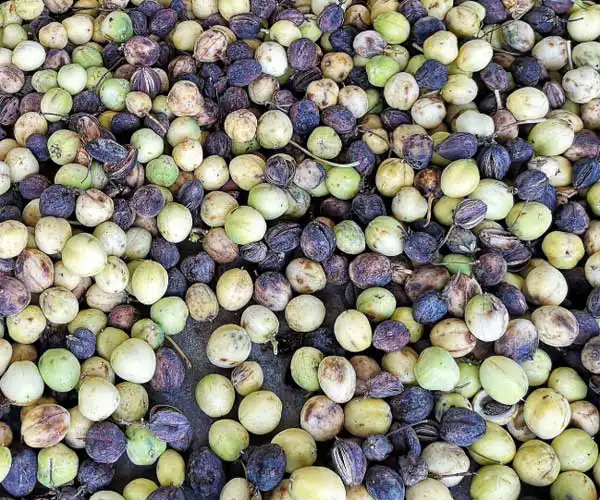Jatropha Curcas – Background Information
- Scientific name: Jatropha curcas
- Common names: Physic nut, purging nut
- Family: Euphorbiaceae
- Origin: Mexico and Central America (??)
- Occurs wildly in almost all tropical and sub-tropical countries of the world
- Perennial shrub – grows up to about 5-6m height
- Grows well in warm tropical climates
- Plant is drought tolerant, adaptable and thrives on nutrient poor soils

- Flowering and fruiting seasonal usually connected to the rainy seasons
- Fruits containing 2-4 seeds, usually 3.
- Dry fruit weighs about 2.5g, 60% weight seeds and 40% weight fruit husk
- The seeds contain about 37.5% by weight shell, 30-40% oil and the rest mostly protein
- Two varieties of Jatropha curcas occur naturally: conventional non-edible jatropha plants and a phenotypically similar, but edible variety called Xuta, which lacks compounds called phorbol esters present in the non-edible varieties.
- Traditional uses: fence plant around small farms, medicinal purpose, edible variety (called Xuta in Mexico) used as human food in Mexico
- Pollination is by insects, usually honey bees
- The plant, even the edible variety, is non-edible to grazing animals, but honey produced from it is edible
- Conventional, non-edible Jatropha plants are familiar backyard and fence plants in many countries and people are familiar with it and its non-edible nature.
Jatropha plantation products
Pruned biomass:
to keep the plants at a height of about 2m, pruning would be required every year. Depending on plant nature and size between 1.5 and 5kg dry matter would be generated from 1 plant through pruning
Jatropha fruit fractions:
the major production item from the jatropha plantation are the fruits. They yield the following fractions on processing.
The fruits can be mechanically shelled using simple locally made machinery. Both fresh and dried fruits can be de-husked. The wet husk is ideal for mulching the plantation. For dry fruits mulch forms about 40% w/w. Dry husk has an energy content of 14MJ per kg and can be used as burning fuel.

The seeds form 60% /w of the dried fruits. They can be mechanically shelled into Shell and kernel.

Jatropha shell (mechanically shelled) forms about 37.5% of the dry seed. It has a high energy content of 18MJ/kg and is a good burning fuel.

Kernel forms about 62.5% of the dry seeds and can be crushed to separate oil and kernel meal.

Jatropha oil forms about 60% w/w of the kernel and is an ideally fuel oil and feed stock for bio-diesel and bio-aviation-fuel. Edible jatropha oil has potential to become an ideal edible oil.
Average fatty acid composition (%) of Jatropha curcas seed oil
| Oleic acid (C-18:1) | 35-51% |
| Linoleic acid (C-18:2) | 27-42% |
| Palmitic acid (C-16:0) | 9-22% |
| Stearic acid (C-18:0) | 5-8% |
| Arachidic acid (C-20:0) | 0-2% |
| Myristic acid (C-14:0) | 0-2% |
| Palmitoleic acid (C-16:1) | 0-1% |
Typical physical/chemical properties of Jatropha curcas seed oil
| Calorific value | 37.8 MJ/kg |
| Appearance | Light yellow liquid |
| Specific gravity at 30°/30° | 0.92 |
| Acid value | 1.24 |
| Saponification value | 197 |
| Iodine value | 102 |
| Unsaponifiable matter | 0.004 |
Edible jatropha kernel cake forms about 40% w/w of jatropha kernels, contains about 60% crude protein and is an ideal animal and fish feed ingredient. Its protein have a high nutritional quality also for humans.
Conventional non-edible jatropha seeds are crushed without deshelling, yielding about 28% w/w of oil and the rest seed cake. This contains 3-4.5% N, 0.65-1.2% P2O5, 0.8-1.4% K2O and 0.2-0.35% S and has been scientifically proven to be an excellent organic fertilizer. The phorbol esters present in the seed cake act as a biological pesticide particularly against soil nematodes, slugs and snails that are harmful to plants.





